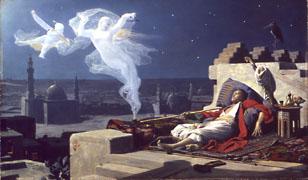From Homer to the Harem
dal 21/6/2004 al 19/9/2004
Segnalato da
21/6/2004
From Homer to the Harem
Dahesh Museum of Art, New York
Jean Lecomte du Nouy derived his subjects primarily from classical history, the Bible, and his own travels to Egypt, Morocco, and Romania. Through these themes, he visualized a chronologically distant past and a geographically distant present. To be presented only at the Dahesh, this retrospective of more than 100 paintings, oil sketches, and drawings will encompass almost all of Lecomte du Nouy's located works, and is unlikely to be repeated in our lifetimes.

The Art of Jean Lecomte du Nouÿ
Jean Lecomte du Nouÿ (1842-1923) derived his subjects primarily from classical history, the Bible, and his own travels to Egypt, Morocco, and Romania. Through these themes, he visualized a chronologically distant past and a geographically distant present.
As a favorite student of the renowned academician Jean-Léon Gérôme (1824-1904), Lecomte du Nouÿ enjoyed several undisputed triumphs at the Salon and consciously avoided modernism, sustaining instead the beau idéal, the traditional sense of beauty closely tied to a high degree of finish and empirical realism. His oeuvre provides a fascinating case study of 19th-century academic art, especially because he was so widely discussed by critics in his own day. For most of the twentieth century, however, he was forgotten, yet the extraordinary visual power of many of his works has rendered him increasingly relevant in the post-modern era.
To be presented only at the Dahesh, this retrospective of more than 100 paintings, oil sketches, and drawings will encompass almost all of Lecomte du Nouÿ's located works, and is unlikely to be repeated in our lifetimes.
Image:
Jean Lecomte du Nouÿ
The Dream of a Eunuch, 1874,
oil on panel, 15 1/2 x 25 3/4 in. (39.3 x 65.4 cm),
Cleveland Museum of Art
Dahesh Museum of Art
580 Madison Avenue (between 56th and 57th Streets)
New York, NY 10022



